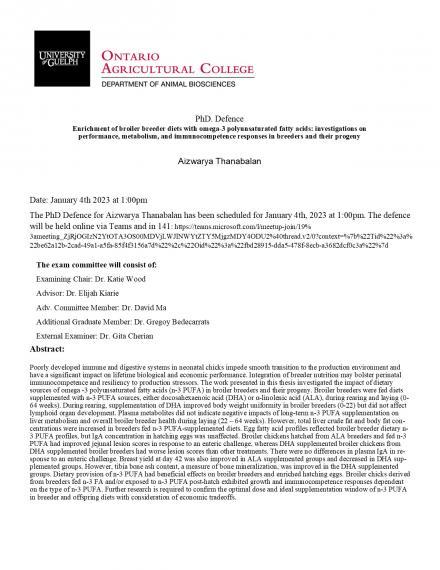Ash Thanabalan's PhD Defence
Date and Time
Location
Room 141 and Teams: https://teams.microsoft.com/l/meetup-join/19%3ameeting_ZjRjOGIzN2YtOTA3OS00MDVjLWJlNWYtZTY5MjgzMDY4ODU2%40thread.v2/0?context=%7b%22Tid%22%3a%22be62a12b-2cad-49a1-a5fa-85f4f3156a7d%22%2c%22Oid%22%3a%22fbd28915-dda5-478f-8ecb-a3682dcf0c3a%22%7d

Details
Poorly developed immune and digestive systems in neonatal chicks impede smooth transition to the production environment and have a significant impact on lifetime biological and economic performance. Integration of breeder nutrition may bolster perinatal immunocompetence and resiliency to production stressors. The work presented in this thesis investigated the impact of dietary sources of omega -3 polyunsaturated fatty acids (n-3 PUFA) in broiler breeders and their progeny. Broiler breeders were fed diets supplemented with n-3 PUFA sources, either docosahexaenoic acid (DHA) or α-linolenic acid (ALA), during rearing and laying (0-64 weeks). During rearing, supplementation of DHA improved body weight uniformity in broiler breeders (0-22) but did not affect lymphoid organ development. Plasma metabolites did not indicate negative impacts of long-term n-3 PUFA supplementation on liver metabolism and overall broiler breeder health during laying (22 – 64 weeks). However, total liver crude fat and body fat con-centrations were increased in breeders fed n-3 PUFA-supplemented diets. Egg fatty acid profiles reflected broiler breeder dietary n-3 PUFA profiles, but IgA concentration in hatching eggs was unaffected. Broiler chickens hatched from ALA breeders and fed n-3 PUFA had improved jejunal lesion scores in response to an enteric challenge, whereas DHA supplemented broiler chickens from DHA supplemented broiler breeders had worse lesion scores than other treatments. There were no differences in plasma IgA in re-sponse to an enteric challenge. Breast yield at day 42 was also improved in ALA supplemented groups and decreased in DHA sup-plemented groups. However, tibia bone ash content, a measure of bone mineralization, was improved in the DHA supplemented groups. Dietary provision of n-3 PUFA had beneficial effects on broiler breeders and enriched hatching eggs. Broiler chicks derived from breeders fed n-3 FA and/or exposed to n-3 PUFA post-hatch exhibited growth and immunocompetence responses dependent on the type of n-3 PUFA. Further research is required to confirm the optimal dose and ideal supplementation window of n-3 PUFA in breeder and offspring diets with consideration of economic tradeoffs.